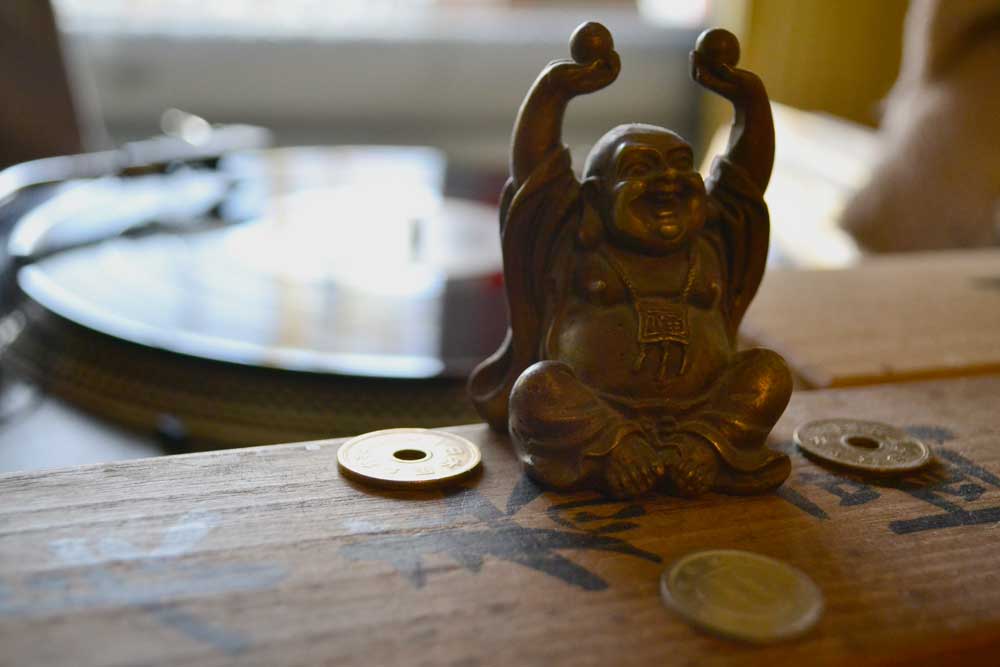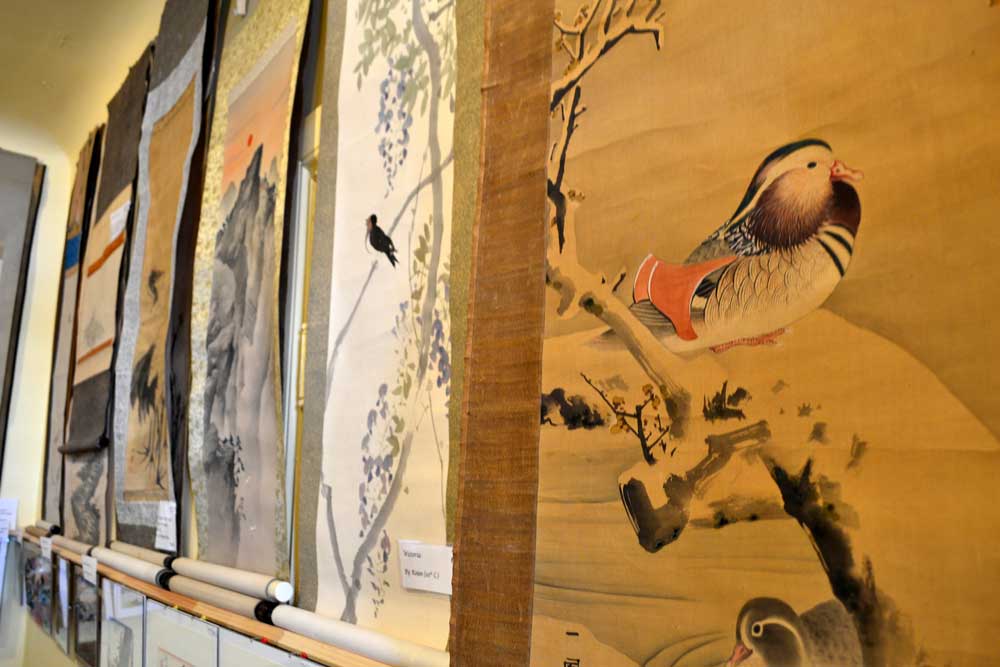Article by Katie Yantzi (JET 2011-2013, Akita Prefecture). Reprinted with permissions from Archenemy Magazine.

Just steps away from the bustle of Kensington market lies a quiet haven of art from across the Pacific. Though the actual degree of quiet depends on what’s spinning from the record player. Paradise Bound (270 Augusta Ave.) is a shop that sells a fascinating pairing of things owner Grey Coyote loves most: good tunes and good old Japanese art.
“Old” is definitely the operative word here. Coyote has rare original works dating from the eighteenth century, which likely once belonged to samurai. The intricately designed pieces adorning the shop’s walls are known as kakejiku, meaning “hanging scroll,” and they can fetch anywhere from $100 to $3000.
“There are many artisans involved in the whole process,” says Coyote as he points out the various components of each scroll—the handmade silk; washi, meaning the sturdy Japanese paper; the delicate ink scenes; and jikusaki, the roller ends used to hold the scrolls in place. Finally, one artisan, “a mounting artist, much like our framing artists”, assembles the final scroll.

Coyote engages us in a spontaneous art history lesson, describing the dedication and discipline required of artists looking to master the craft. “These are artists who worked their [behinds] off, painting twelve or more hours per day…practicing, practicing, practicing.” He elaborates on the requisite years of studying the Chinese and Japanese classics, as well as the strict adherence to method and style. The carefully cultivated skill and reverence for the craft contrasts sharply with today’s loose experimentation and more fluid contemporary styles.
But there’s more to the seemingly innocuous paintings of birds, flowers, waterfalls, and fruit than just some pretty illustrations. “One of the most important things—one of the most interesting things—is the ancient Asian nature symbolism,” Coyote declares, which was used in most pieces to confer luck and fortune upon the home where the painting was hung. Swallows represent fidelity, while plum blossoms are images of overcoming adversity. Dragons symbolize strength and higher learning. Coyote pauses to gaze thoughtfully at the images in front of him.
“Poets understand this.”
Since the shop isn’t busy, Coyote unfurls two scrolls from the back room, hanging them side by side to form a complete image (sofuku). “This is shijo-ha, of the Maruyama shijo school,” a style of painting founded in Kyoto in the 1700s. “One of their great talents is painting something without painting it.” Coyote asks if we can see what that is. “Don’t look for something… tiny. Look for something very obvious,” he hints.
We stare in silence for one long minute. Suddenly, the invisible becomes unmistakably clear.
“Snow?”
Coyote nods. Negative space is expertly used to shape the mounds of white powder clinging to the branches between the birds.
Some of the paintings Coyote has on display have an even deeper political meaning than the nature symbolism suggests. “Most of the old literati painters were on the side of restoring the emperor and ending the shogunate,” Coyote explains. “They knew what was happening in the rest of the world. They knew about democracy.”
One artist in particular, Ukita Ikkei, was jailed for nine years for a painting that ridiculed the shogun’s attempt to marry into the royal family. “He did not keep a civil tongue,” Coyote states. Another of Ikkei’s paintings depicts a seemingly innocent paper fan and a butterfly. “A fan and two butterflies is love and affection. A fan and one butterfly,” Coyote says with a mischievous grin, “is arrogance and vanity.” The average Japanese Joe wouldn’t have known the meaning behind all of the nature symbolism. “They trusted the literati painters to give them something auspicious. Apparently Ukita-san did not care for this patron.” Coyote laughs darkly. “That was in his nature. It got him killed.”
These artists are the stuff of legends, and Coyote intends to one day study their political involvement in more detail, which he says is well-documented “but…nowhere near finished.” Although their discipline and singular pursuits may at first seem uptight, they’re arguably just as [bad—] as star-throwing ninjas and sword-wielding samurai.
Art continues to be a medium to challenge power structures and social norms. The possibilities of subtle communication are as boundless as the artist’s creativity. Despite the initially staid appearance of kakejiku, the independent spirit of Kensington makes it the perfect Toronto home for these unexpectedly subversive works of art.
Did we mention the great record collection!
///////
PARADISE BOUND
270 Augusta Ave.
416-916-7770
Archenemy is a Toronto based quarterly magazine profiling local and independent Creatives, projects and culture in Toronto. Learn more at: archenemymagazine.com Follow them on Twitter, Facebook and Instagram.

























